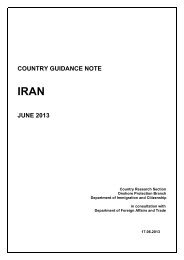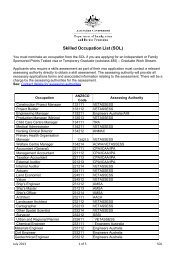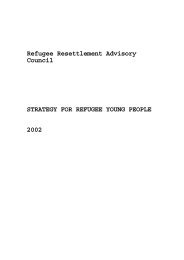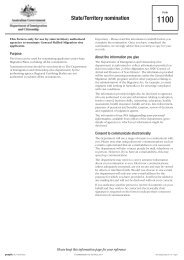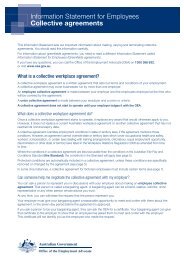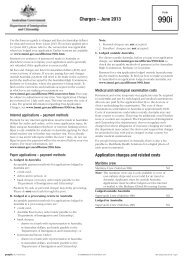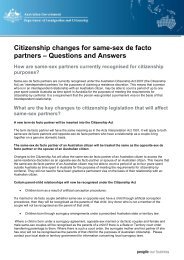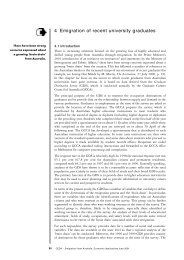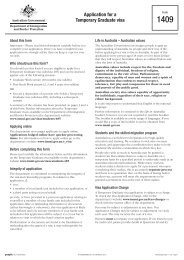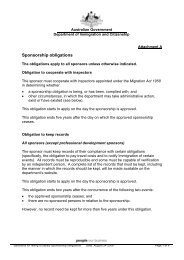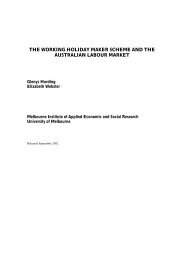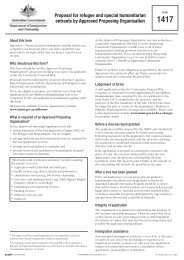Evaluation of the Integrated Humanitarian Settlement Strategy (IHSS)
Evaluation of the Integrated Humanitarian Settlement Strategy (IHSS)
Evaluation of the Integrated Humanitarian Settlement Strategy (IHSS)
You also want an ePaper? Increase the reach of your titles
YUMPU automatically turns print PDFs into web optimized ePapers that Google loves.
2.2 <strong>IHSS</strong> 1<br />
2.2.1 Historical overview<br />
Until <strong>the</strong> 1970s, humanitarian entrants were eligible for accommodation at migrant hostels, along with<br />
o<strong>the</strong>r migrants who arrived by assisted passage. However it became clear that more specialised<br />
assistance was needed for humanitarian entrants who did not wish to live in migrant hostels. At <strong>the</strong><br />
same time, <strong>the</strong> community sector was seeking a greater role in meeting <strong>the</strong> settlement needs <strong>of</strong><br />
humanitarian entrants.<br />
As a result, <strong>the</strong> Community Refugee <strong>Settlement</strong> Scheme (CRSS), a network <strong>of</strong> volunteer groups, was<br />
established in 1979 to provide assistance to humanitarian entrants with finding accommodation and<br />
employment, general orientation and social support. At <strong>the</strong> same time <strong>the</strong> Committee for <strong>the</strong><br />
Allocation <strong>of</strong> Loan Funds to Refugees in Centres (CALFRIC) was established to provide support for<br />
humanitarian entrants who wished to move from hostels into private housing by <strong>of</strong>fering interest-free<br />
loans to cover associated costs.<br />
The CRSS and CALFRIC initiatives reflected formal recognition <strong>of</strong> <strong>the</strong> specific needs <strong>of</strong> humanitarian<br />
entrants as a distinct category and initiated a partnership between government and <strong>the</strong> wider<br />
community in <strong>the</strong> provision <strong>of</strong> settlement assistance. They also diversified settlement services by<br />
providing an alternative to migrant centres.<br />
A review <strong>of</strong> migrant hostels in 1984 led to <strong>the</strong> closure <strong>of</strong> several hostels and a general shift towards<br />
self-contained accommodation. In 1986, <strong>the</strong> Review <strong>of</strong> Migrant and Multicultural Programs and<br />
Services recommended that accommodation should be provided only for those with limited financial<br />
resources, and especially for humanitarian entrants. It also recommended a shift to self-contained,<br />
self-catering units with co-located support services. DIMIA established <strong>the</strong> On Arrival Accommodation<br />
(OAA) Scheme in order to provide this kind <strong>of</strong> accommodation for humanitarian entrants. The former<br />
migrant centres were closed and replaced with government-leased flats.<br />
From <strong>the</strong> mid-1980s <strong>the</strong>re were three categories <strong>of</strong> assistance:<br />
OAA was provided for <strong>the</strong> highest needs entrants, refugee visa holders without proposers and<br />
permanent visa holders released from detention without family or community support. They were<br />
eligible for thirteen weeks <strong>of</strong> accommodation in government-leased flats, with extensions for<br />
cases <strong>of</strong> special need. After <strong>the</strong> first week <strong>of</strong> accommodation, entrants in <strong>the</strong> OAA service<br />
generally paid approximately 30% <strong>of</strong> <strong>the</strong>ir welfare benefits as rent and a small weekly contribution<br />
towards utilities. Their eventual move to private accommodation was assisted by CALFRIC loans.<br />
As CALFRIC was phased out from <strong>the</strong> mid-1990s, DIMIA developed a Rent Rebate Scheme by<br />
which entrants whose rent and utility contributions had been paid in full were eligible for a rebate<br />
<strong>of</strong> four weeks rental contribution. The OAA accommodation served as a useful base for access to<br />
o<strong>the</strong>r settlement support services.<br />
CRSS volunteers supported o<strong>the</strong>r high needs entrants - those without links in Australia, who had<br />
experienced torture or trauma and refugee women entering under <strong>the</strong> ‘Women at Risk’ category.<br />
Entrants were met at <strong>the</strong> airport and assisted with general orientation, practical assistance and<br />
social support, generally for six months after arrival. DIMIA provided a contribution <strong>of</strong> around<br />
$1,100 for single entrants and a fur<strong>the</strong>r $300 per family member to enable volunteer groups to<br />
recover some <strong>of</strong> <strong>the</strong> costs involved. CRSS volunteers also proposed families.<br />
1<br />
This information was provided by DIMIA and replicates <strong>the</strong> information in <strong>the</strong> <strong>Settlement</strong><br />
Services Review (SSR).<br />
<strong>Evaluation</strong> <strong>of</strong> <strong>the</strong> <strong>Integrated</strong> <strong>Humanitarian</strong> <strong>Settlement</strong> <strong>Strategy</strong> 27 May 2003<br />
4



